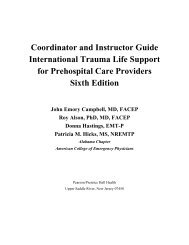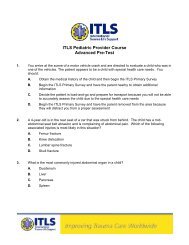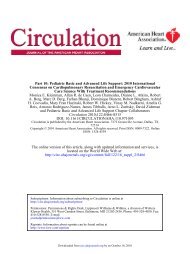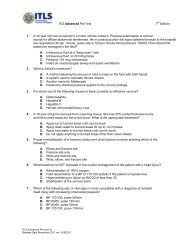ITLS Basic Pre-Test 7th Edition Page 1 - Wizard Education
ITLS Basic Pre-Test 7th Edition Page 1 - Wizard Education
ITLS Basic Pre-Test 7th Edition Page 1 - Wizard Education
You also want an ePaper? Increase the reach of your titles
YUMPU automatically turns print PDFs into web optimized ePapers that Google loves.
<strong>ITLS</strong> <strong>Basic</strong> <strong>Pre</strong>-<strong>Test</strong> 7 th <strong>Edition</strong><br />
31 . Which one of the following mnemonics can be used to help predict which patients might<br />
potentially have difficult bag mask ventilation?<br />
A. MMAP<br />
B. IPPV<br />
C. RSI<br />
D. BOOTS<br />
32 . An unrestrained 18 year old male on the way to a post-graduation party leaves the road, bounces<br />
through a ditch and hits a tree. You find him behind the bent steering wheel, unconscious,<br />
cool, pale and clammy, with labored respirations of 30 and shallow, thready radial pulses of<br />
about 120, flat neck veins, trachea midline, an asymmetrical chest with absent breath<br />
sounds on the left. You assume he has a:<br />
A. Cardiac tamponade<br />
B. Tension pneumothorax<br />
C. Massive hemothorax<br />
D. Simple pneumothorax<br />
33 . A 23 year old female has won the “Let’s-see-who-can-lean-the-farthest-backward-overthe-second-story-balcony-railing”<br />
contest. You arrive to find her boyfriend standing<br />
over her, holding two beers, as she lies on the grass under the balcony. She opens her<br />
eyes to voice, her skin is normal in color, respirations about 16 and unlabored, pulse 54<br />
and a little weak at the wrist, with no external bleeding. She has flat neck veins, a normal<br />
chest and abdomen and a stable pelvis. First responders who arrived just before you,<br />
tell you that her pulse ox reading is 94 and her blood pressure is 74/30. If this is true,<br />
A. Hypovolemic shock<br />
B. Relative hypovolemic (high-space) shock<br />
C. Mechanical (obstructive) shock<br />
D. Cardiogenic shock<br />
34 . Which of the following may affect the reliability of a pulse oxymetry reading?<br />
A. Cyanide poisoning<br />
B. High ambient light<br />
C. Carbon monoxide poisoning<br />
D. All of the above<br />
35 . During the Primary Survey you recognize your patient is in need of immediate ventilator support, you<br />
delegate this intervention to a team member and you continue the Primary Survey. This delegation of<br />
interventions is called:<br />
A. the “Just Do It” process<br />
B. the “Treat It as You Find It” process<br />
C. the “Get It Done” process<br />
D. the “Fix It” process<br />
36 . Which of the following conditions is your FIRST priority in management of a trauma patient?<br />
A. Open the airway and assess for breathing<br />
B. Provide ventilator support for your patient<br />
C. Control major external bleeding<br />
D. Begin chest compressions if pulses are absent<br />
<strong>Page</strong> 5







